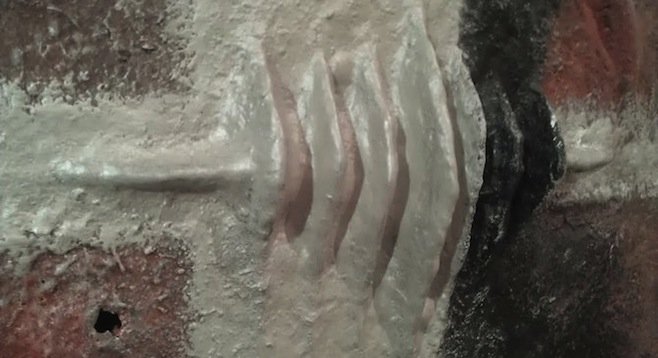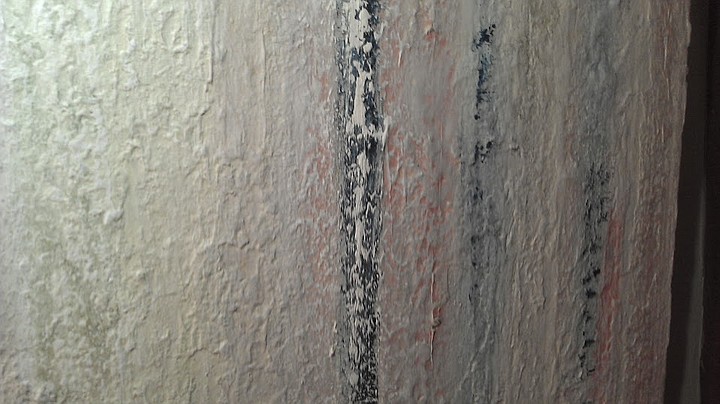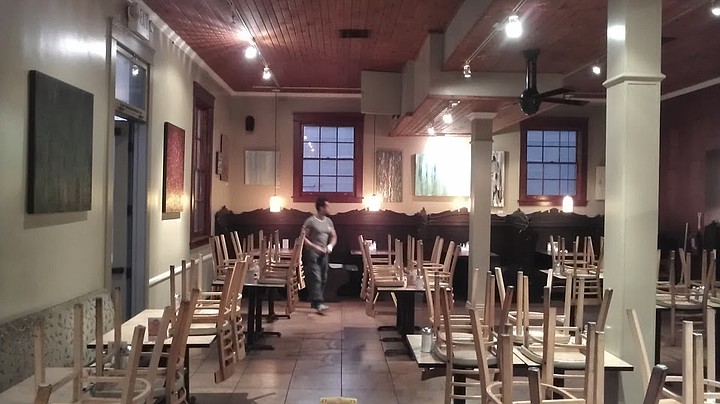 Facebook
Facebook
 X
X
 Instagram
Instagram
 TikTok
TikTok
 Youtube
Youtube

“I don’t know if you’ve ever had a chance to look at a picture of the cosmic microwave background. It’s basically the afterbirth of the Big Bang. This is sort of an interpretation of that, of the emerging universe,” says Dr. Spencer Epps as he inspects “Baby Picture of the Universe,” one of the paintings he has just hung for display on the walls of the Mission restaurant in the East Village. Then, he starts talking about the peculiarities of spacetime and the discrepancies between emerging cosmological phenomena and the intrinsic qualities of space, mass, and energy.

Epps, who quickly reveals himself as a very smart man, speaks in a near whisper, tying his words together as thoughts run through his mind, one subject bleeding into another.
“'Dark Tower' represents your mind. Are you master of your mind, or are you a slave to your mind?” he says, indicating another painting hanging from the restaurant’s walls. Epps recently completed a series as a commentary on mental illness, and “Dark Tower” deals with the voice of loathing and self-doubt that many people associate with their insecurities. In the painting, an ominous shape lurks behind a wash of bold colors, each one impressionistically laid over the next, creating a thick impasto of anxious tones.
“Co-dependence is a pandemic,” Epps explains, moving on to his next painting with boundless energy. “[In “Interdependence”], the orange and the blue are my couple, and we see them at different stages of the timeline together.” Masked behind a subdued wash, the orange and blue bars of “Interdependence” fade to and from prominence, blending into each other in a visual representation of what Epps refers to as “a normal, healthy relationship.”

In “Broken Circuit,” a raised sculpture in the middle of the canvas represents a sort of mental loop that’s broken down and needs to be circumvented. White energy pools at one side of the sculpture, blackness lurks at the other.
The textural nature of “Broken Circuit” is extreme, but it’s that tactile sensation that characterizes Epps’ style. The artist is new to painting, having only been doing it full time for a year and a half, and he has taken to the medium with a sense of curiosity that reflects his ability to float from cosmology to psychosis and beyond. He casually references the old masters when he talks about his love of layering paints.
“If you mix white and black paint, you get grey. But if you paint a layer of black paint, then put a layer of white paint over it, you get blue. Isn’t that amazing?” says Epps. “Because I’m not formally trained, I didn’t learn a lot of the rules until later. Like, I didn’t know that you’re not supposed to mix oil and acrylic paints. I do a lot of experimenting. I’m always mixing household objects into my paint to see what kind of textures I can get.”
Epps likes to work fine cornmeal into the paint, because it gives it “a beautiful fibrous texture” when it dries. He also uses the balls of silica gel from the "DO NOT EAT" packets. Since the silica is a powerful desiccant, it sucks moisture in from the paint and creates perfect little spheres along the surface of the painting. The effect can be seen at the Mission in “Sanguis,” his portrait of red blood cells, done as part of a series on “the elements.”

“We each have a tiny ocean inside of us,” Epps says of human blood. When he speaks, there’s genuine awe in his voice, as though the miracles of life and the world were something that he is excited to share with everyone.
And the irony isn’t lost on Epps that his paintings, on display for a month at a popular breakfast restaurant, will be seen by a lot of people. Probably more than if they hung in a gallery, although the difference between being “seen” on a restaurant wall and being “looked at” in a gallery can be marked.
Epps works out of the 10th Avenue Arts Center, and a big focus for him is expanding into more arts outreach, especially to youth.
“Art can open the mind,” he says. “I like to choose a subject that can make people think, that can expand their minds. If you and I meet each other, and let’s say we’re on opposite ends of some political spectrum, we can talk at each until we’re blue in the face and go on and on. I’d be using all the rubrics that I have, all the stuff that I know, but art forces me to open my mind.”
In what might be the quintessential Dr. Spencer Epps moment, the painter likens art’s interference with perception to the “bumpiness” of physics, saying that the only reason we have anything in the world is because energy and matter collide, accumulating and forming everything that is. Art interferes with ideas in the same way, causing them to glom together and become something greater.
Heavy? Yes, but also pretty cool.


“I don’t know if you’ve ever had a chance to look at a picture of the cosmic microwave background. It’s basically the afterbirth of the Big Bang. This is sort of an interpretation of that, of the emerging universe,” says Dr. Spencer Epps as he inspects “Baby Picture of the Universe,” one of the paintings he has just hung for display on the walls of the Mission restaurant in the East Village. Then, he starts talking about the peculiarities of spacetime and the discrepancies between emerging cosmological phenomena and the intrinsic qualities of space, mass, and energy.

Epps, who quickly reveals himself as a very smart man, speaks in a near whisper, tying his words together as thoughts run through his mind, one subject bleeding into another.
“'Dark Tower' represents your mind. Are you master of your mind, or are you a slave to your mind?” he says, indicating another painting hanging from the restaurant’s walls. Epps recently completed a series as a commentary on mental illness, and “Dark Tower” deals with the voice of loathing and self-doubt that many people associate with their insecurities. In the painting, an ominous shape lurks behind a wash of bold colors, each one impressionistically laid over the next, creating a thick impasto of anxious tones.
“Co-dependence is a pandemic,” Epps explains, moving on to his next painting with boundless energy. “[In “Interdependence”], the orange and the blue are my couple, and we see them at different stages of the timeline together.” Masked behind a subdued wash, the orange and blue bars of “Interdependence” fade to and from prominence, blending into each other in a visual representation of what Epps refers to as “a normal, healthy relationship.”

In “Broken Circuit,” a raised sculpture in the middle of the canvas represents a sort of mental loop that’s broken down and needs to be circumvented. White energy pools at one side of the sculpture, blackness lurks at the other.
The textural nature of “Broken Circuit” is extreme, but it’s that tactile sensation that characterizes Epps’ style. The artist is new to painting, having only been doing it full time for a year and a half, and he has taken to the medium with a sense of curiosity that reflects his ability to float from cosmology to psychosis and beyond. He casually references the old masters when he talks about his love of layering paints.
“If you mix white and black paint, you get grey. But if you paint a layer of black paint, then put a layer of white paint over it, you get blue. Isn’t that amazing?” says Epps. “Because I’m not formally trained, I didn’t learn a lot of the rules until later. Like, I didn’t know that you’re not supposed to mix oil and acrylic paints. I do a lot of experimenting. I’m always mixing household objects into my paint to see what kind of textures I can get.”
Epps likes to work fine cornmeal into the paint, because it gives it “a beautiful fibrous texture” when it dries. He also uses the balls of silica gel from the "DO NOT EAT" packets. Since the silica is a powerful desiccant, it sucks moisture in from the paint and creates perfect little spheres along the surface of the painting. The effect can be seen at the Mission in “Sanguis,” his portrait of red blood cells, done as part of a series on “the elements.”

“We each have a tiny ocean inside of us,” Epps says of human blood. When he speaks, there’s genuine awe in his voice, as though the miracles of life and the world were something that he is excited to share with everyone.
And the irony isn’t lost on Epps that his paintings, on display for a month at a popular breakfast restaurant, will be seen by a lot of people. Probably more than if they hung in a gallery, although the difference between being “seen” on a restaurant wall and being “looked at” in a gallery can be marked.
Epps works out of the 10th Avenue Arts Center, and a big focus for him is expanding into more arts outreach, especially to youth.
“Art can open the mind,” he says. “I like to choose a subject that can make people think, that can expand their minds. If you and I meet each other, and let’s say we’re on opposite ends of some political spectrum, we can talk at each until we’re blue in the face and go on and on. I’d be using all the rubrics that I have, all the stuff that I know, but art forces me to open my mind.”
In what might be the quintessential Dr. Spencer Epps moment, the painter likens art’s interference with perception to the “bumpiness” of physics, saying that the only reason we have anything in the world is because energy and matter collide, accumulating and forming everything that is. Art interferes with ideas in the same way, causing them to glom together and become something greater.
Heavy? Yes, but also pretty cool.
Comments